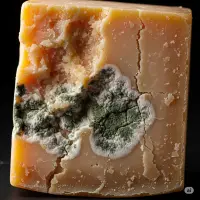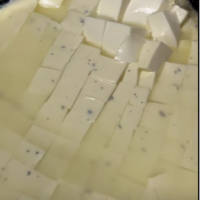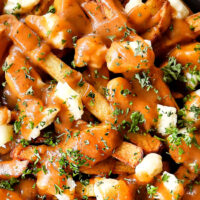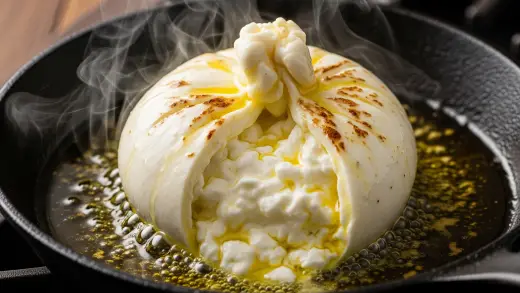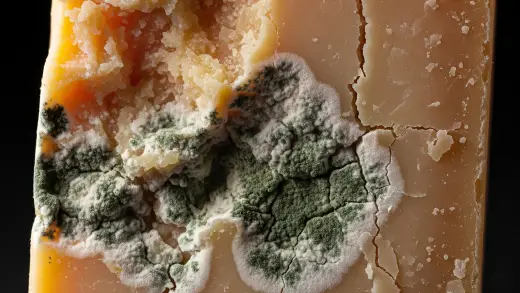Brie does not have a wax coating. Its outer layer is a bloomy rind, a soft, white mold that is edible and contributes to the cheese’s flavor.
Wax coatings are found on some other cheeses like Gouda and are not meant to be eaten. They should be removed before consumption.
Ever wondered about that soft, white, fuzzy blanket hugging your slice of brie? It looks kind of interesting, right? Well, that’s the rind, and brie is a super popular cheese known for this special outer layer.
So, the big question: can you actually eat that rind? The answer is a definite YES! That bloomy rind, as it’s sometimes called, is totally edible. It’s actually a big part of what makes brie, well, brie!
This rind isn’t just there for looks. It develops as the cheese ages, thanks to some friendly molds. These molds help give brie its smooth, creamy inside and also contribute to its unique, earthy flavor.
Some people think the rind has a stronger, more mushroomy taste than the inside, while others find it mild and delicious.
Think of it like the crust on a loaf of bread – it’s a bit different in texture and taste from the soft inside, but it all works together. So next time you have a piece of brie, go ahead and give the rind a try! You might just discover your new favorite part.

Can You Eat the Wax on Brie?
The waxy coating you sometimes see on cheese, like Gouda, is not meant to be eaten. It’s a food-safe wax that’s applied to help preserve the cheese.
However, the white, soft rind on Brie is absolutely edible and, in fact, contributes to the cheese’s flavor and texture. This rind is a result of the natural aging process and the specific molds used to make Brie.
So, to be clear:
- The rind on Brie: Yes, you can and often should eat it. It’s part of the cheese.
- A waxy coating (like on Gouda): No, this is for preservation and should be removed before eating the cheese.
You can indeed eat the rind of Brie cheese. In fact, the rind is a natural and essential part of the cheese.
Here’s what you should know about the Brie rind:
Composition
The white, bloomy rind on Brie is formed by a mold called Penicillium candidum. This is a beneficial mold that is intentionally introduced during the cheesemaking process. It helps to ripen the cheese from the outside in and protects it from harmful bacteria.
Edibility
This type of mold is completely safe to eat. The rind is not a separate layer but rather a result of the cheese maturing.
Flavor and Texture
The rind contributes to the overall flavor and texture of the Brie. It often has a mild, slightly earthy, and sometimes mushroomy taste.
The texture can range from soft and velvety to a bit firmer than the creamy interior. Many people find that the rind enhances the taste experience of the Brie.
Preference
Whether to eat the rind or not is ultimately a matter of personal preference. Some people enjoy the flavor and texture it adds, while others may find it not to their liking.
Serving
When serving Brie, it is generally recommended to cut it in wedges so that each serving includes a portion of the rind. This allows everyone to experience the full flavor profile of the cheese. If you prefer not to eat the rind, you can simply trim it off on your plate.
Exceptions
While the white, moldy rind of Brie is edible, you should not eat rinds that are made of wax (like on some Goudas) or cloth.
These are artificial coatings used to protect the cheese during aging and are meant to be removed.
Also, if you see any blue or green mold on your Brie, this indicates spoilage, and the entire cheese should be discarded.
So, go ahead and enjoy your Brie, rind and all! It’s part of what makes this cheese so special.
Why You Should Eat the Brie Rind (Benefits & Flavor)
The Brie rind offers a unique dimension to the overall tasting experience. It often imparts an earthier, sometimes subtly mushroomy flavor that complements the rich, buttery interior beautifully.
Beyond the taste, the rind provides a delightful textural contrast. The slightly firmer exterior gives way to the soft, melting heart of the cheese, creating a more complex and interesting mouthfeel.
Interestingly, in many cheese-loving cultures, particularly in France, eating the rind is not only common but considered part of the proper way to enjoy Brie.
It’s seen as essential to experiencing the full spectrum of flavors the cheesemaker intended.
Are There Any Downsides to Eating Brie Rind? (Addressing Concerns)
So, you’re wondering if there are any downsides to eating brie rind, right? It’s a good question to ask when you’re enjoying that soft, creamy cheese. While the white rind is often part of what makes brie so special, there are a couple of things you might want to consider.
Generally, eating the rind of brie is safe, and it even adds to the cheese’s unique taste and feel. Harmless molds, mainly Penicillium candidum, create that bloomy outside layer.
Many cheese lovers actually think the rind gives the brie an earthy, almost mushroom-like flavor that goes really well with the rich, buttery inside.
However, just like with any food, there can be a few potential drawbacks, though they don’t happen very often:
A Tiny Risk of Listeria
Although it’s rare, there’s a small chance of a bacteria called Listeria monocytogenes being on the surface of soft cheeses like brie. This bacteria can cause a foodborne illness called listeriosis.
Good cheesemakers follow strict cleaning rules to keep this risk low, but it’s still something to be aware of.
Pregnant people, older adults, and those with weaker immune systems are usually advised to avoid soft cheeses with rinds because of this potential issue.
A Bit of an Ammonia Taste
Sometimes, as brie gets older, the rind can develop a slightly bitter or even smell and taste like ammonia. This happens as the cheese breaks down proteins.
It’s not harmful, but it can be unpleasant and might make you enjoy the cheese less. If your brie rind smells strongly of ammonia, it’s probably best to cut it off.
Not Everyone Loves the Texture
Let’s be real, the slightly fuzzy or firm feel of the rind isn’t for everyone. Some people just prefer the smooth, creamy inside. If that’s you, it’s totally fine to remove the rind before you dig in.
So, to put it simply, most people happily eat the brie rind and enjoy how it adds to the cheese’s overall experience.
However, it’s always a good idea to be aware of the small risk of listeria (especially if you’re in a higher-risk group), any weird flavors like ammonia, and whether you actually like the texture.
In the end, whether you eat the rind or not is really up to you and depends on the specific piece of brie you have.
How To Cut Brie For Serving?
Let’s get down to slicing that delicious brie! Here’s a quick guide on how to cut it properly for serving:
Wedges are Best
Cut brie into wedges, like you would a pie. This ensures everyone gets a bit of the rind (if you’re serving it with the rind on) and the creamy interior.
Small Rounds
For small, round bries, cut them in half and then into wedges.
Larger Wheels
For larger wheels, cut a wedge from the center first to show others how to serve themselves, then continue cutting wedges.
Avoid Cutting the “Tip”
The very center or “tip” of a brie wedge is often considered the most flavorful part, so try to slice in a way that everyone gets a piece that includes some of this.
How to Best Enjoy Brie (with or without the rind)?
To truly appreciate the nuances of Brie, whether you choose to eat the rind or not, allow it to come to room temperature for about 30 minutes before serving. This softens the cheese and intensifies its flavors.
When serving Brie on a cheese board, it’s customary to cut it into wedges. This ensures that everyone gets a portion that includes both the creamy interior and the rind, allowing them to experience the cheese as a whole.
Etiquette-wise, it’s generally advised against scooping out the center of the Brie and leaving a ring of rind behind. If you prefer not to eat the rind, discreetly cut it away from your wedge on your plate.
Ultimately, it’s a matter of personal preference, but trying the rind is highly recommended to fully appreciate the cheese.
What About Other Cheese Rinds? (Expanding Knowledge)
The “bloomy rind” of Brie is just one type of edible cheese rind. You’ll encounter other varieties, such as washed rinds, which are often brushed with brine, beer, or wine during aging, resulting in pungent and often orange-hued rinds.
Herb-coated rinds, as the name suggests, are encrusted with flavorful herbs that add another layer of taste and texture.
It’s important to distinguish these edible rinds from non-edible ones.
Cheeses encased in wax (like some Goudas) or wrapped in cloth (often seen with aged cheddars) have rinds that are meant to protect the cheese during aging and should be removed before consumption.
Conclusion
In conclusion, the Brie rind is a fascinating and often flavorful component of this beloved cheese. Formed by beneficial molds, it plays a vital role in the ripening process and contributes unique tastes and textures.
While personal preference dictates whether you eat it or not, trying the rind is highly encouraged to experience the full complexity of Brie.
So, the next time you have a slice of Brie, be adventurous! Take a bite with the rind and discover a new dimension of flavor. What are your thoughts on eating Brie rind? Share your experiences in the comments below.






